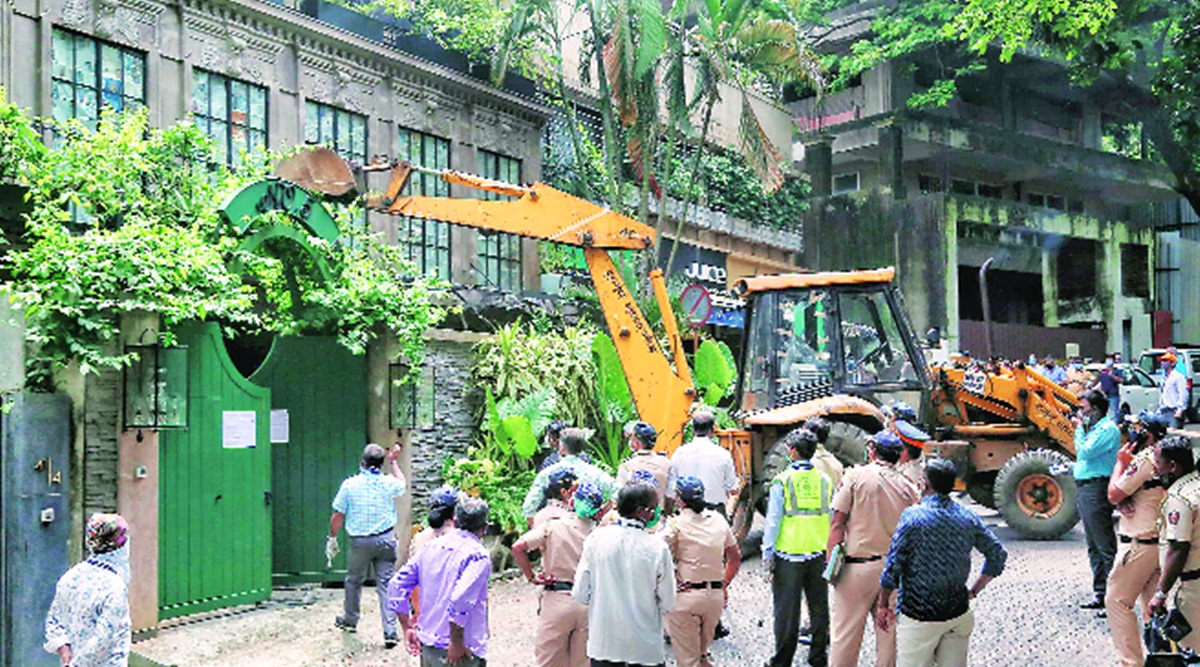 Illegal constructions at actor Kangana Ranaut’s office at Pali Hill in Mumbai were demolished by BMC on Wednesday. (File)
Illegal constructions at actor Kangana Ranaut’s office at Pali Hill in Mumbai were demolished by BMC on Wednesday. (File)In recent days, the properties of actor Kangana Ranaut and designer Manish Malhotra have come under the Brihanmumbai Municipal Corporation’s (BMC) scanner for alleged illegal alterations.
BMC’s action against illegal constructions is mainly based on complaints from people or any unauthorised work detected by civic staff during routine inspections. Any deviation from approved plans can be considered “illegal”. However, when it comes to action against illegal constructions, presence of two parallel laws and ambiguity on using them give power to officers to decide which law should be applied in a particular case.
The BMC either invokes the Mumbai Municipal Corporation (MMC) Act, which was incorporated before Independence in 1888, or the Maharashtra Regional & Town Planning (MR&TP) Act while serving notices for illegal alterations.
The laws allow only “tenantable repairs” in an already constructed building for which permission from the BMC is not required. For any other alteration apart from those listed as “tenantable repairs”, BMC’s permission is required and in the absence of such permission the work is deemed illegal.
“Tenantable repairs” include plastering, painting, changing floor tiles and repairing bathrooms. However, any change in existing horizontal and vertical dimensions of the structure and replacement or removal of any structural parts of load bearing walls is deemed illegal.
In April 2013, as per an amendment made in the Maharashtra Regional and Town Planning (MR&TP) Act, 1966, the BMC effected reforms in the functioning of assistant engineers (building and factory) of local ward offices. These ‘designated officers’ have been given power to tackle mushrooming illegal constructions in the city and in case of no action against unauthorised constructions the ‘designated officers’ are held responsible.
There are two sections under both MMC Act and MR&TP Act under which the BMC issues notices. Under Section 354 (A) of MMC Act, the BMC issues ‘stop work notice’ for ongoing unauthorised construction. But if civic staff detects illegal construction that has been completed, then notice is issued under Section 351 of MMC Act.
A civic official said while under Section 354 (A) the owner or occupier of the property is given 24 hours to submit documents to prove legality; under Section 351 a person is given seven days to provide legal documents. In both cases, if the BMC finds the reply and documents unsatisfactory it can initiate demolition. “After the demolition we send notice to the owner of the property for recovery of cost. If the owner does not pay then it is added to the property tax bill,” a BMC official said.
Notice is also served under Section 53 (1) and 55 (1) of MR&TP Act against illegal addition and alteration in existing structure and change of use of land and unauthorised temporary development, respectively. While in 53 (1) occupier or owner of premises is given one month to reply, in 55 (1) it is 15 days. Unlike MMC Act, in MR&TP Act the entire process takes over a month. Also, in MR&TP, regularisation of illegal construction if possible can be done under the Development Control Rules. Another difference is, if notice is served under MR&TP and if the owner fails to provide documents, then FIR can be filed and the person sent to jail with penalty.
The MMC Act is more used in cases of illegal constructions. An assistant engineer (building and factory) from the eastern suburbs explained that in the past courts had pulled up the civic body for ‘delaying action’ on illegal constructions.